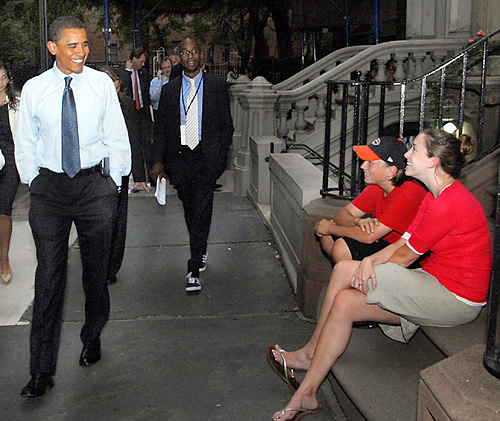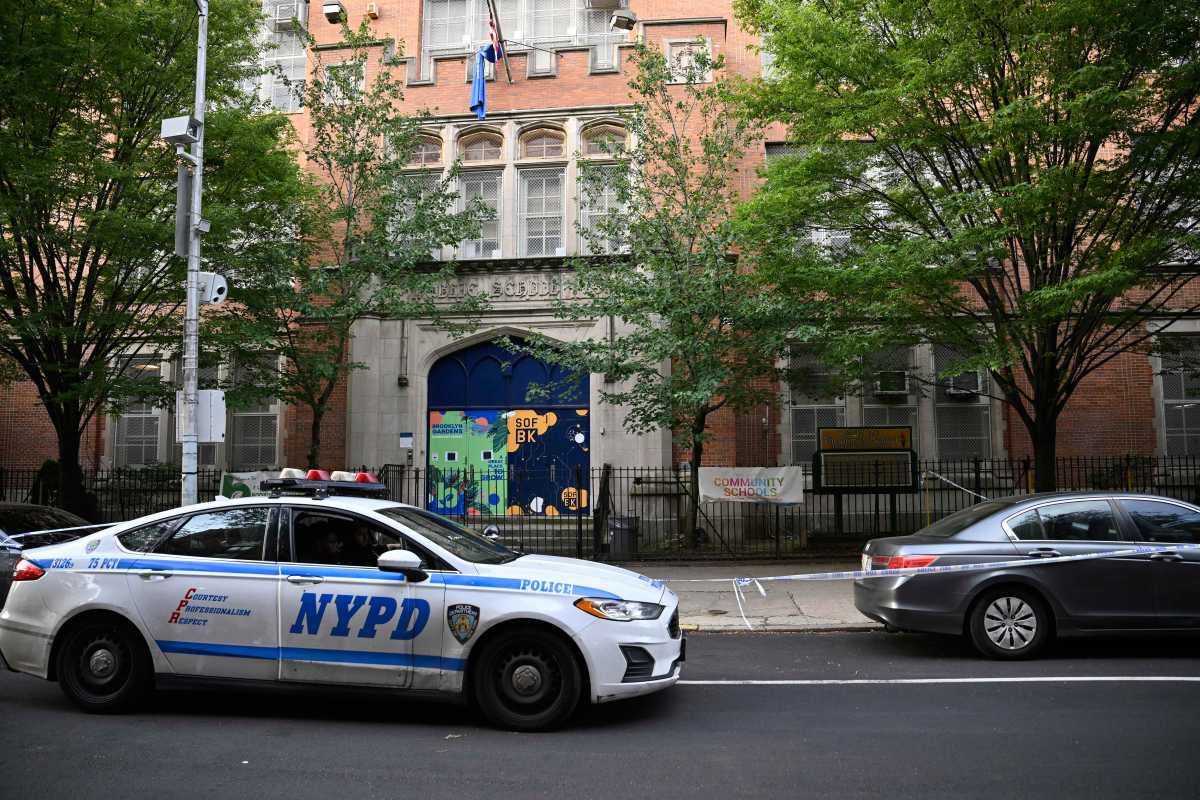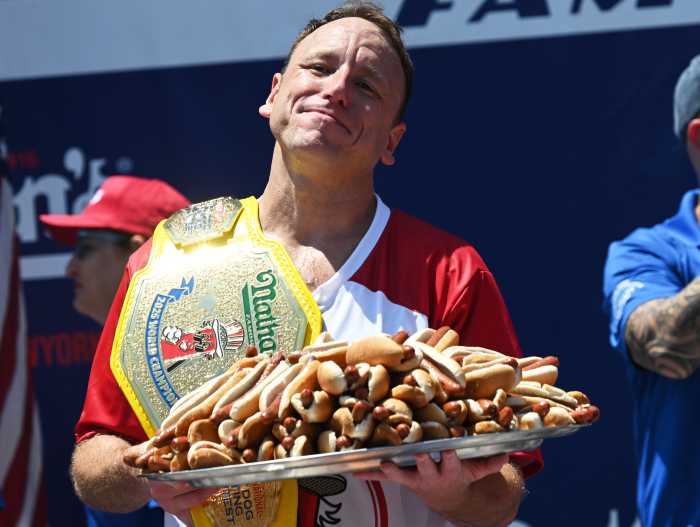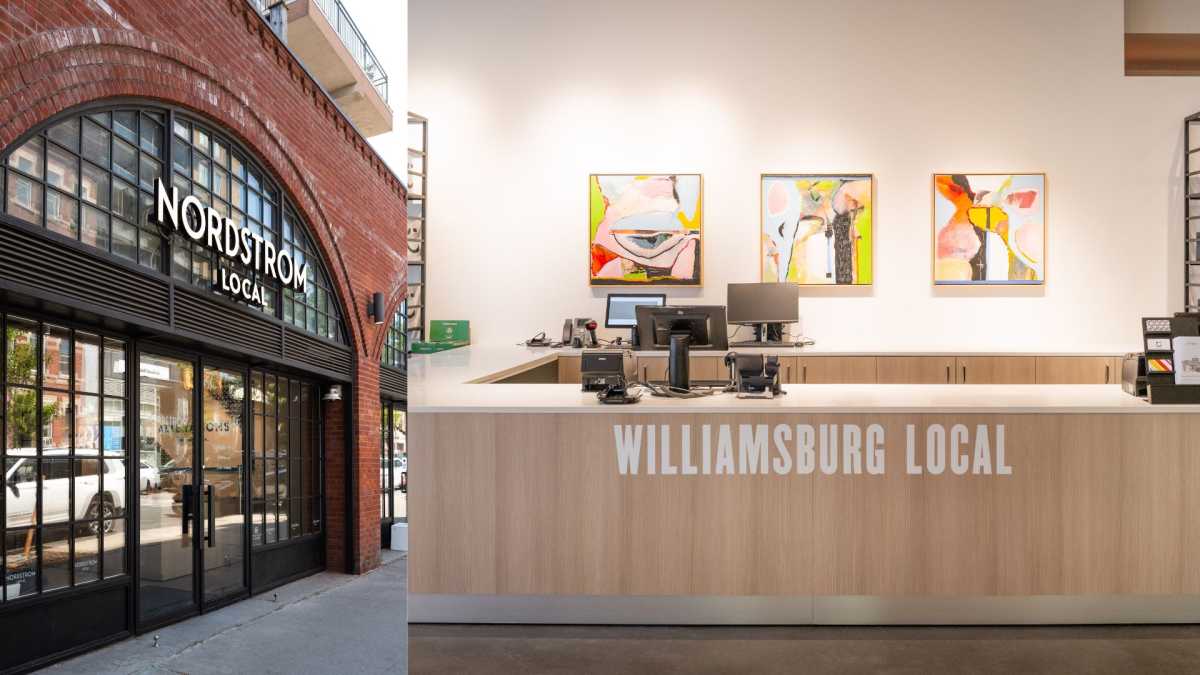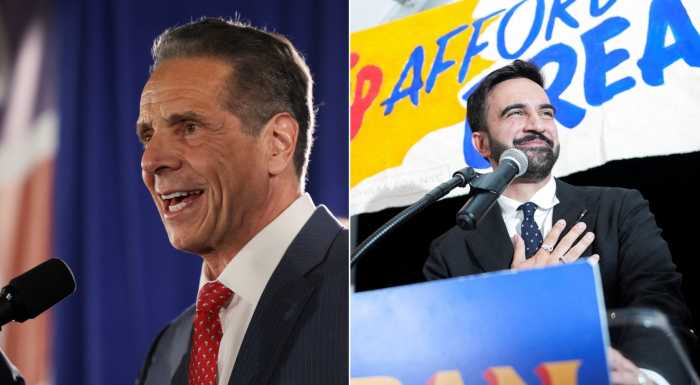Brooklyn has changed, and The Brooklyn Paper has been through it all the way. From urban renewal to the “brownstoners” to the young urban professionals, every newsmaker we covered had, in his or her small way, a role in creating “The New Brooklyn.”
Here’s our look back at some of the biggest stories of the past three decades (in no particular order!):
Business & commerce
1. Fulton mauled: The original vision called for a Minneapolis-style enclosed-walkway shopping experience linked to Modernist office towers on Flatbush Avenue, but by the 1980s, that had been scaled back to an attractively paved car-free mall paid for with federal mass transit funds. Planners hoped an attractive mall would bring back middle-class shoppers and also attract new residents of nearby neighborhoods — but it accomplished neither.
Three of the mall’s four department stores — E.J. Korvette, Martin’s and J.W. Mays — shuttered within a few years, and the lone survivor — A&S — shrank considerably and was rebranded a Macy’s; the venerable Gage & Tollner restaurant was eventually replaced by a TGI Fridays; even the mall’s brick walkways are now being replaced by conventional sidewalks.
The mall nevertheless remained a magnet for shoppers; its storefronts were in such demand that they commanded among the highest rents in the country. Yet the anchor-less indoor Albee Square Mall at Fulton Mall’s eastern end was a failure, in part because many of its stores were duplicates of what could be found outside on Fulton. Albee was eventually acquired by Bruce Ratner, who did an encouraging makeover (bringing in Toys R Us as an anchor tenant) and considered linking it to his nearby Metrotech office campus. Now it’s a hole in the ground.
2. Bank bust: Local savings banks and savings and loans — originally locally owned “mutual” institutions — first merged and then were taken over by distant entities. Among fabled Brooklyn names lost in translation: Independence Savings, Williamsburgh Savings, Dime Savings Bank of Brooklyn (no relation to the Dime of Williamsburg that recently appropriated the old Dime of Brooklyn logo), Brooklyn Savings, Metropolitan Savings, Bay Ridge Federal, Hamilton Federal and The Greater.
3. Vacuum filled: There was a gradual corporate collapse in Brooklyn — accentuated by the loss of the borough’s locally owned banks and of the A&S corporate headquarters (which moved to Manhattan), as well as the decline, moving, closing or merging of such mega-sized businesses as Pfizer (founded in Williamsburg), Brooklyn Union Gas (a big player in the Brownstone revival, but now part of National Grid), New York Telephone, and other significant Brooklyn-based institutions. These losses created a civic and business leadership vacuum in Brooklyn now being filled by real-estate developers, back office operators, and entrepreneurs.
4. We’ll drink to that: Brooklyn Brewery resurrected, on a small scale, what was once a king-sized Brooklyn industry, and microbrewers followed; restaurant rows sprung up along strips long written off — the progenitors of Smith Street in Cobble Hill and Carroll Gardens are so numerous that last week, Mayor Bloomberg said his buddies often prefer to eat in Brooklyn.
5. Storing the borough: Studies said it, Brooklynites knew it — the borough’s “under retailed.” Some retail developments — like Bruce Ratner’s Atlantic Center and Atlantic Mall near Downtown, Gateway mall in southeast Brooklyn, and the Target-anchored Flatbush Junction near Brooklyn College — were welcomed. Others — like Charlie Katz’s foiled Brooklyn Junction on the edge eastern edge of Bay Ridge, and a scrapped shopping mall at the old postal center off Hamilton Avenue (now a Lowe’s) — were opposed as threats to nearby commercial strips, generators of traffic woes, and aesthetic offenses. Costco opened in Sunset Park to wide acclaim, and that neighborhood’s commercial strips continue to thrive; there are multiple Home Depots, and neighborhood hardware stores live on. Today, speculation persists — along with strong feelings on both sides — about the eventual placement of other big box stores, including a Walmart, in Brooklyn.
Sports & Culture
6. Baseball returns: The Dodgers left after the 1957 season — and with them went the borough’s proud (and long) tradition of professional sports. But thanks to the Mets — with an assist from baseball-mad Mayor Giuliani — a pro team (albeit a minor-league one) returned to Brooklyn in 2001 when the Cyclones took the field at the new Keyspan Park in Coney Island. Giuliani steamrolled local leaders’ hopes for a “Sportsplex” complex, pumped in lots of taxpayer bucks, and then illegally tore down the old Thunderbolt rollercoaster in the middle of the night, but he got Keyspan Park built. Though always competitive, the Clones haven’t won a New York–Penn League championship since their inaugural year, allowing Brooklynites to revive another tradition from the Dodger days: the annual cry of “Wait ’til next year!”

7. Rolling the ‘Dice’: The world knows him as Andrew Dice Clay, but for us, he’ll always be Andy Silverstein, the John Travolta lookalike who worked for his dad’s process-serving business on Court Street. Our intrepid reporter Laurie Sue Brockway spotted Andy doing his act one day — he was always doing his act! — and broke the biggest entertainment story to come out of Downtown Brooklyn since Woody Allen. Her first story ran in 1979, and it predicted the Dice Man’s coming greatness.
8. Winning the culture war: Perhaps it started with Spike Lee in Fort Greene. Perhaps it was Paul Auster or Steve Buscemi in Park Slope. Or maybe it was the publication of Jonathan Lethem’s “Fortress of Solitude” in 2003. But sometime within the last two decades, Brooklyn went from a backwater to being the cultural center of the world. The list of luminaries who’ve migrated (in some cases back) to Brooklyn is too long to run in our print edition, as is the list of institutions that fill New Yorkers’ cultural calendar. But it includes St. Ann’s Warehouse, Bargemusic, the Brooklyn Academy of Music and its relatively new Harvey Theater, and on and on and on.
9. Who’s a bum now?: This story was too crazy to be believed. The Brooklyn Dodgers abandoned the borough in 1957. Then, in 1988, three Bay Ridge guys opened a Third Avenue bar called “The Brooklyn Dodger,” filling the inside with baseball memorabilia. Everyone loved the joint — except the now Los Angeles Dodgers, who sued for copyright infringement. After an epic legal battle, the bar owners — the Davids against the baseball Goliaths — won. “The SOBs got what they deserved,” owner Kevin Boyle told us when the case was finally won in 1993.
10. Quite a ‘Sensation’: The most controversial story to come out of the arts community was the Brooklyn Museum’s decision to show off British art collector Charles Saatchi’s Modern art holdings in a 1999 show called “Sensation.” The show was controversial long before it hit the borough — thanks primarily to a single work: a Chris Ofili portrait of the Madonna enhanced with elephant dung and butterfly shapes cut out from porno mags. Then-Mayor Giuliani practically had an aneurysm from the piece and pulled $7-million in city funding. Free speech advocates manned the other side of the hustings, effectively demonizing the mayor as “anti-art” — not a position in which the man who liked to champion New York as the “capital of the world” wanted to find himself. The funding was restored, Giuliani was succeeded by Bloomberg and the museum got what it wanted: publicity.
Development
11. Brownstone Brooklyn: A movement by middle class New Yorkers to reclaim worn — very worn — historic neighborhoods around Downtown Brooklyn accelerated in the late 1970s and early ’80s. While properties could be gotten for a song, the work necessary to convert them into desirable habitats was both risky and considerable. The environment was often less than welcoming — many blocks were crime-ridden and it took a leap of faith to envision a bright future. Major Brooklyn institutions, including Brooklyn Union Gas (through its Cinderella program) and Con Edison (through Renaissance), encouraged the reclamation effort; banks began competing for business in neighborhoods that they had only recently been redlining; the Brooklyn Union Gas–hosted Brownstone Fair was a hub of creative energy. When the lights went out during the terrible 1977 blackout (just before The Paper started publishing), gas lamps — supplied by the Cinderella program — illuminated block parties on attractive Brownstone Brooklyn blocks, while nearby neighborhoods burned.
12. The new Brooklynites: Office and manufacturing buildings, schools and churches went residential, meeting an insatiable demand. After the Ex-Lax building on Atlantic Avenue in Boerum Hill became a co-op, many others followed, including St. John’s University on Schermerhorn Street, the Insurance Building on Clinton Street, 66 Court Street, the Eagle Warehouse at Fulton Ferry, and majestic churches. Even the Williamsburgh Savings Bank tower lost its teeth, as dentists were evicted to make room for new residents.
13. ‘Witnesses’ to the future: The Watchtower Bible and Tract Society, also known as the Jehovah’s Witnesses, had begun their expansion before the Brownstone revolution, acquiring the massive Squibb Pharmaceutical buildings near Fulton Ferry. Their expansion continued through the 1970s and 1980s with hotel takeovers that included the Margaret, Bossert, Standish Arms and Towers, 360 Furman Street, and a “sliver” building on Livingston Street. Several of these structures have recently been sold to private or other institutional owners as the Watchtower continued expansion of an upstate campus.
14. The Eichner sanction: Developer Bruce Eichner rubbed the Brooklyn Heights establishment the wrong way. Eichner’s home at the Pierrepont Street entrance to the Promenade, which incorporated modern elements in a designed deemed sufficiently suitable for the historic district, was praised by architectural critics but opposed by Heights leaders. When his carefully restored Margaret Hotel was totalled by fire days before completion and Eichner sought a variance to rebuilt it to its pre-fire height, the Brooklyn Heights Association fought back. Eichner won, rebuilt the Margaret and, to the BHA’s angst, sold it to the Jehovah’s Witnesses.
At 360 Furman Street (the massive structure now known as One Brooklyn Bridge Park), Eichner devised a creative plan to save at least some of the building’s manufacturing jobs — by splitting the building, with high-end residential occupants on the water side, and manufacturers on the side facing the gritty Brooklyn-Queens Expressway. After facing BHA opposition, he sold it to the Watchtower, and all manufacturing jobs were lost.
15. Brooklyn Bridge Park: Shipping on the Brooklyn Heights waterfront declined as container ports in New Jersey and Red Hook thrived. The Port Authority, tired of the cost of maintaining a facility it no longer needed, sought in the mid-1980s to fill the site with low-rise housing and open space — enraging park advocates who favored a large and diverse greenspace, and Brooklyn Heights civics who saw their community’s viewplane threatened.

The plan was hooted down, and the concept of a Brooklyn Bridge Park, stretching from Atlantic Avenue to the Manhattan Bridge, emerged. The notion of a public park radically changed when the site became a state economic development project: recreational components would have to be paid for by revenue generated from housing or commercial development on site. Unable to start such development in the current recession, project administrators began some relatively simple open space construction this year.
16. New upscale enclaves: All it took was a simple rezoning for the Fourth Avenue corridor in Park Slope, the Williamsburg waterfront and Flatbush Avenue Extension to burst forward with new residential development. The real-estate bust has caused a temporary glut in units, but experts believe that they’ll all be filled — maybe not at the high-end prices developers were seeking — eventually. People want to live in Brooklyn — even if the buildings to which they move aren’t as attractive as some would like.
17. The fire this time: In The Paper’s early years, the St. George Hotel was a cancer in Brooklyn Heights. Rundown, with a decrepit subway arcade favored by homeless sleepers, there was little hope of redemption for the one-time biggest hotel in the city when a new owner failed to capitalize on a real-estate boom to convert his property to co-op or condo residences. Then, in 1995, a major arson fire destroyed a big part of the site, though eventually, the St. George was stabilized and became a residence for students from several New York City colleges.
18. The biggest project ever: Proposed in 2003 as the biggest development in Brooklyn’s history, Bruce Ratner’s $4-billion Atlantic Yards project — including housing and commercial components and an arena for the New Jersey Nets built around a superblock in Prospect Heights — met unexpectedly strong opposition and was stalled until the current recession forced at least a temporary cutback in its scope. As 2009 winds down, final lawsuits may be resolved to permit the start of some construction, providing financing can be had.
Politics
19. Oy!hara: There have been better scandals, but the saga of perennial candidate John Kennedy O’Hara is one of the greats. In the mid-1990s, O’Hara had been a thorn in the Brooklyn political establishment’s side. He backed rebel candidates. He campaigned against chosen party hacks. He made noise. And he railed against District Attorney Charles Hynes. Then he did something really wrong: He voted in an election. Problem was, O’Hara voted in a neighboring election district — and Hynes prosecuted him for it! The result was a long and drawn out legal battle that led to O’Hara’s conviction — the only person besides Susan B. Anthony to be prosecuted for the crime. He was disbarred and did his community service. Then fought to be reinstated as a lawyer — which happened this year.
20. Obama in Brooklyn: This was the greatest news story that we didn’t know about: When he was a law student at Columbia in the early 1980s, future President Barack Obama lived in both Park Slope and Brooklyn Heights. “I don’t remember the exact address,” he told The Brooklyn Paper in 2007, referring to his Park Slope home, where he is believed to have lived for about a year-and-a-half. “Then, I subletted for about three months in Brooklyn Heights, near the Promenade. On Sunday mornings, there was a bagel shop near the subway station, and I would go there and pick up a coffee and New York Times.” If we had only known. Who knows? We might be head of the FCC today!
21. Party Marty: While many people don’t know the names of their elected officials, in Brooklyn almost everyone knows Borough President Markowitz. He can walk down any street and elicit excited cries of, “Hey Marty!” and his boosterism for the borough is infectious; despite having virtually no power to do anything, he manages to get the name “Brooklyn” repeated all over the world. But the borough is split over Markowitz’s support for Bruce Ratner’s Atlantic Yards project, which required a subversion of the normal city planning process, a sweetheart land deal for the developer and large public subsidies. Whether it is ultimately great for Brooklyn or not, it’s Markowitz’s legacy.
22. Scandalous behavior: This may not be Chinatown, but it is Brooklyn, where the politics are rough and tumble. While most of our pols and judges are honorable folk, we’ve had more than a handful who wandered off the straight and narrow. To wit:
• Rep. Fred Richmond, reputedly the richest man in Congress at the time he was forced to resign in 1982, was investigated for allegedly committing, while in office, such crimes as harboring an escaped convict, possession of cocaine, “feigning” retirement from his company while continuing to exert control, and campaign financing regularities. Afterwards, an apparently distraught lover committed suicide in his apartment.
• Former Brooklyn Democratic Party boss and 11-term Assemblyman Clarence Norman was jailed in 2007 for soliciting a campaign contribution from a lobbyist above the legal limit and for pocketing a $5,000 campaign contribution. Small potatoes? The convictions were part of District Attorney Charles Hynes’s larger investigation of a “pay to play” judicial system that alleged that Norman sold judgeships in Brooklyn and forced judicial candidates to use his hand-picked campaign consultants.

• City Councilman Angel Rodriguez went to jail in 2002 for demanding a bribe worth more than $1.5 million from the developer of a Red Hook supermarket, in exchange for his support. “All I have to say is I’m extremely sorry,” he said when sentenced to four years and four months.
• Assembly Speaker Mel Miller automatically lost his seat because of his fraud and conspiracy in the theft of $200,000 from clients of his law firm. Referring to Miller and an aide who was also convicted, the sentencing judge said, “What makes this so serious is that they are men of prominence, educated men, officers of the court.”
• District Attorney Eugene Gold prosecuted Son of Sam and other notorious criminals during four terms. After leaving office, an incident at a prosecutor’s convention in Nashville in 1983 led to his admitting that he had “engaged in unlawful sexual conduct” and “unlawful sexual fondling” of a 10-year-old.
Crimes & misdemeanors
23. Day of infamy: No story over these 30 years matches the horror of 9-11 and its impact on The Brooklyn Paper’s readers. The relatives and friends and firemen and police who died; the terror seen, heard and smelled from the Brooklyn Heights promenade that morning; the shocked survivors streaming across the Brooklyn Bridge and through Downtown Brooklyn en route home; the debris from the Trade Center that settled on Brooklyn for days afterwards — all left indelible marks.
24. Homegrown terror: Terror plots in the years before and after the 1993 World Trade Center bombing and the 9–11 attack periodically put Brooklyn on edge. Trade Center bomb planners preached in mosques on Atlantic Avenue and in Kensington; on March 1, 1994, in the wake of the assassination of Arabs in Hebron by an Israeli from Brooklyn, a gunman open fire in traffic on the Brooklyn Bridge and killed rabbinical student Ari Halberstram; alleged terror plots were exposed in Park Slope, where bombs were being produced in an apartment for deployment in the Atlantic-Pacific subway complex. A long forgotten case of pre-Trade Center terror took the life of a resident above the Tripoli Restaurant on Atlantic Avenue in Cobble Hill in 1982. That arson case remains unsolved.
25. The ‘Burn Boy’: When Charles Rothenberg set fire to his 6-year-old son David, the Carroll Gardens community rallied to support David and his mother Marie. The horrific crime, committed during a custody dispute in 1983, left David with critical burns over 90 percent of his body and permanently disfigured. His mother remarried and resettled with David in California — and the story was the subject of the made-for-TV movie, “David,” starring Bernadette Peters and John Glover. Father Charles earned a maximum sentence — 13 years — but was paroled after less than seven.
26. Councilman slain: In one of the most shocking crimes to ever happen inside City Hall, a political rival to Councilman James E. Davis (D–Fort Greene) shot and killed his enemy from the gallery in the Council chamber before a security officer gunned him down. Davis’s own warmth and trusting nature indirectly led to his July 23, 2003 demise. On that day, Davis hoped to mend fences with Othniel Askew by inviting him to City Hall, where he planned to mention him from the gallery. Even in those post–9-11 days, councilmembers could spirit their guests through City Hall security screening by merely saying, “He’s with me.” Davis’s brother Geoffrey tried to succeed his sibling, but Letitia James, running on the Working Families Party line, won the election and remains the district’s councilwoman to this day.
27. Tense times: Racial tensions were rarely far from the surface through the 1990s. The Rev. Herbert Daughtry staged noisy Christmas-season rallies outside Fulton Mall department stores, demanding jobs under the threat of a boycott; Yusuf Hawkins, a black youth, was stabbed to death by a white mob in Bensonhurst — and when the Rev. Al Sharpton marched there in protest, he was stabbed; bitterness and justice followed the police torture (and coverup) of Haitian immigrant Abner Louima; Sharpton and Sonny Carson led nasty demonstrations against Korean merchants on Church Avenue, and Crown Heights erupted in days of anti-Jewish rioting following a traffic accident that claimed a black youngster’s life.
And the rest
28. One hundred and going strong: The Brooklyn Bridge Centennial was like no party before — except maybe the one for the span’s opening in 1883. The nation’s attention focused on New York Harbor as fireworks spilled from the bridge to commemorate what had been the world’s greatest engineering feat, and to cheer Brooklyn and New York as the epitome of American progress. Then in 1986, the world returned on the Fourth of July to view, from the then-grubby streets of Red Hook, past the chain-link fences into New York Harbor, an arresting display of fireworks encasing Lady Liberty on her 100th birthday.
29. For whom the toll tolls: For the entirety of The Brooklyn Paper’s history, the city has been talking about tolling the East River bridges — and borough leaders have been screaming about it. Mayor Bloomberg’s congestion pricing plan — and a more limited version proposed by Gov. Paterson — have come close. The specter will be raised again soon enough.

30. Number’s up: Remember when the entire city had one area code? Few new Brooklynites do, but in 1983, New York Telephone (remember them?) proposed a new area code — 718 — for Brooklyn. Borough President Howard Golden protested vehemently, saying that a new area code would isolate Brooklyn. But others, most notably then–Chamber of Commerce President Joseph French, saw the new area code as a means to strengthening Brooklyn’s independent feel. In the end, French (who was a telecom executive, by the way) was right. Despite the temporary inconvenience, the new area code still feels hip today. No wonder people put it on T-shirts.


